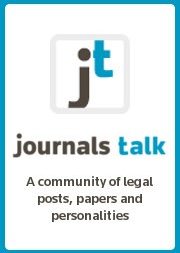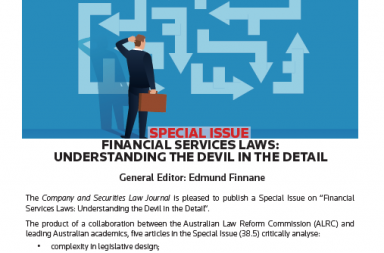*Please note that the links to the content in this Part will direct you to Westlaw AU. If you are using Checkpoint, the links can be found in the Checkpoint PDF at the bottom of this post.
To purchase an article, please email: [email protected] or contact us on 1300 304 195 (Australian customers) or +61 2 8587 7980 (international customers) during business hours (Mon-Fri, 8am-6pm AEST).
The latest issue of the Company and Securities Law Journal (Volume 38 Part 4) contains the following material:
EDITORIAL – Editor: Edmund Finnane
Articles
A Comparative Analysis of Product Intervention Powers in Australia and the United Kingdom – Christopher Chiam
This article reviews the product intervention powers granted to ASIC by comparing it with similar powers vested in the Financial Conduct Authority, a financial regulator in the United Kingdom (UK) with an analogous role to ASIC. It considers three key themes: when and how the power to make product intervention rules can be exercised; the consequences of contravening a product intervention rule; and consultation requirements. In respect of these three themes, differences between each scheme are identified and consideration given to whether the Australian model could be improved by adopting some features from the UK. The article ultimately concludes that three aspects of the UK scheme could prove beneficial: the power to prescribe consequences of a contravention of a product intervention rule; more specific guidance for how ASIC must carry out consultation with affected parties; and specific carve-outs for when consultation is not necessary.
Insights into the Collateralisation of Intangible and Intellectual Property Assets by Non-financial Listed Entities on the ASX/S&P 200 – Professor Tony Ciro and Dr Bülend Terzioglu
The article examines the collateralisation practices of the top 200 ASX/S&P listed entities. Key highlights of the current era include a resurgence of start-ups with intellectual property and other intangibles as their primary assets. Conventionally, lenders display a strong preference for tangible assets as security. Credit providers’ preference for tangible assets for collateral, diminishes the funding options for many entities, especially start-ups, which have a limited asset pool they can pledge. This empirical study uses inductive qualitative content analysis to investigate the extent of disclosures of (1) assets pledged as security and (2) intellectual property in annual reports of the top 200 Australian-listed companies, and to (3) examine the use of intellectual property and intangible assets as collateral with credit transactions. Also examined is whether pitfalls continue to exist with the current intellectual property framework in Australia for companies wanting to collateralise their intangible assets. Results point to high levels of inconsistency in collateral reporting practices.
People, Planet, and Profits: Re-purposing the Company – Ross Grantham
The social and environmental costs imposed by business corporations on society are significant and, as a society, we are increasingly concerned about how to mitigate these impacts. It is this concern and the apparent inability of government to take decisive steps that has made the question of the company’s “purpose†the “hottest topic†in corporate governance. This article explores recent proposals by several highly eminent bodies to fundamentally reconceive of the company as a purposeful entity that exists, not to make profit, but to solve the problems faced by people and planet. The article will assess the normative arguments that underpin these proposals and will highlight the shortcomings of a purposeful company approach.
For the PDF version of the table of contents, click here: Westlaw AU – CSLJ Vol 38 No 4 Contents or here: Checkpoint – CSLJ Vol 38 No 4 Contents
Click here to access this Part on Westlaw AU
Click here to access this Part on Checkpoint
For general queries, please contact:Â [email protected].


